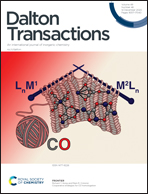Complex formation and cytotoxicity of Triapine derivatives: a comparative solution study on the effect of the chalcogen atom and NH-methylation†
Abstract
α-N-Heterocyclic thiosemicarbazones are an important class of investigational anticancer drugs. The most prominent representative is 3-aminopyridine-2-carboxaldehyde thiosemicarbazone (Triapine), which has shown promising results in clinical trials and is currently evaluated in phase III. In this study, we investigated the influence of a chalcogen atom exchange from S (Triapine) to O (O-Triapine) and Se (Se-Triapine) and the methylation of the hydrazonic NH moiety (Me-Triapine) on their complexation with Fe(II), Fe(III) and Cu(II) ions and their cytotoxicity. The main aim of this study was to characterize and compare the most feasible chemical forms in solution, their stability and redox properties, as well as to reveal the relationships of the solution speciation and kinetic data with cytotoxic activity. The complex equilibria and redox properties of the complexes were characterized by the combined use of pH-potentiometry, UV-visible spectrophotometry, electron paramagnetic resonance spectroscopy, and cyclic voltammetry. These revealed that Se-Triapine forms Cu(II) complexes with higher, and O-Triapine with lower stability as compared with Triapine. Me-Triapine, which is not able to coordinate via the typical (N,N,S−) donor set, nevertheless coordinates to Cu(II) with unexpected high stability. The Cu(II) complexes of Se-Triapine and Me-Triapine can be relatively slowly reduced by glutathione at pH 7.4 (but not by ascorbate), similarly to Cu(II)-Triapine. In contrast, the Cu(II)–O-Triapine complex can be reduced by both reducing agents in rapid redox reactions. Se-Triapine and Triapine form high stability complexes with both Fe(II) and Fe(III) ions, while O-Triapine has a much stronger preference towards Fe(III) and Me-Triapine towards Fe(II). This difference in the iron preference of the ligands seems to have a strong impact on their cytotoxic effects, which was measured in a human uterine sarcoma cell line (MES-SA) and its multidrug-resistant subline (MES-SA/Dx5). The Cu(II) complexes of these calcogensemicarbazones are moderately toxic, and the highest level of ROS generation was found for the Cu(II) complex of O-Triapine, which is the most reducible.



 Please wait while we load your content...
Please wait while we load your content...